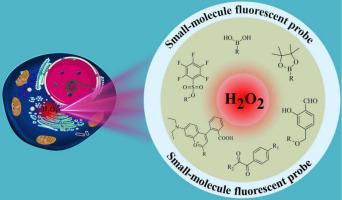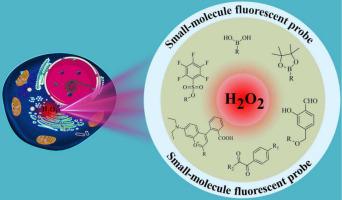用于检测生物系统中过氧化氢的小分子荧光探针
IF 23.5
1区 化学
Q1 CHEMISTRY, INORGANIC & NUCLEAR
引用次数: 0
摘要
过氧化氢(H2O2)是活性氧的关键成员,是参与多种生物活动的重要信号分子。H2O2水平的异常变化与某些症状和疾病有关,如肝损伤、阿尔茨海默病、帕金森病和癌症。迄今为止,小分子荧光探针被认为是监测细胞内活性分子变化的有力工具。其中,大量的H2O2响应小分子荧光探针被广泛构建,用于研究H2O2在生命系统中的动态变化、分布及其重要作用和功能。为了全面了解这些报道的小分子荧光探针的特点,本文综述了它们的设计策略、检测机制、生物学应用以及在发病机制探索中的贡献。重要的是,我们的目的是为开发新一代高质量的荧光探针来监测生物系统中H2O2的波动做出贡献。本文章由计算机程序翻译,如有差异,请以英文原文为准。


Small-molecule fluorescent probes for detecting hydrogen peroxide in biological systems
Hydrogen peroxide (H2O2) is a pivotal member of the reactive oxygen species and an essential signaling molecule that participates in numerous biological activities. Abnormal variations in H2O2 levels are associated with some certain symptoms and diseases, such as liver injury, Alzheimer's disease, Parkinson's disease, and cancer. To date, small-molecule fluorescent probes have been regarded as powerful tools for monitoring changes in intracellular reactive molecules. Therein, masses of H2O2-responsive small-molecule fluorescent probes have been widely constructed and used to investigate the dynamic changes, distributions and important roles and functions of H2O2 in living systems. To provide a comprehensive understanding of the characteristics of these reported small-molecule fluorescent probes, this review summarizes their design strategies, detection mechanisms, biological applications, and contributions to pathogenesis exploration. Importantly, we aim for this review to contribute to the development of a new generation of high-quality fluorescent probes for monitoring H2O2 fluctuations in biological systems.
求助全文
通过发布文献求助,成功后即可免费获取论文全文。
去求助
来源期刊

Coordination Chemistry Reviews
化学-无机化学与核化学
CiteScore
34.30
自引率
5.30%
发文量
457
审稿时长
54 days
期刊介绍:
Coordination Chemistry Reviews offers rapid publication of review articles on current and significant topics in coordination chemistry, encompassing organometallic, supramolecular, theoretical, and bioinorganic chemistry. It also covers catalysis, materials chemistry, and metal-organic frameworks from a coordination chemistry perspective. Reviews summarize recent developments or discuss specific techniques, welcoming contributions from both established and emerging researchers.
The journal releases special issues on timely subjects, including those featuring contributions from specific regions or conferences. Occasional full-length book articles are also featured. Additionally, special volumes cover annual reviews of main group chemistry, transition metal group chemistry, and organometallic chemistry. These comprehensive reviews are vital resources for those engaged in coordination chemistry, further establishing Coordination Chemistry Reviews as a hub for insightful surveys in inorganic and physical inorganic chemistry.
 求助内容:
求助内容: 应助结果提醒方式:
应助结果提醒方式:


